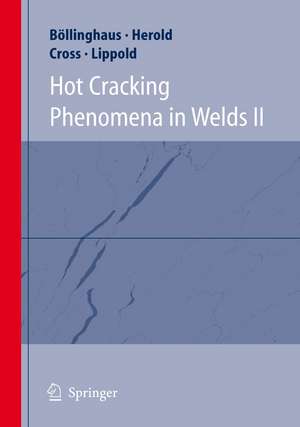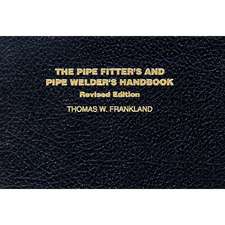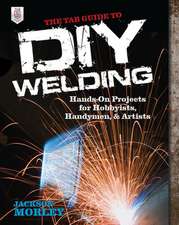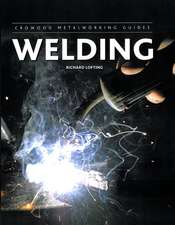Hot Cracking Phenomena in Welds II
Editat de Thomas Böllinghaus, Horst Herold, Carl E. Cross, J C Lippolden Limba Engleză Paperback – 10 noi 2010
| Toate formatele și edițiile | Preț | Express |
|---|---|---|
| Paperback (1) | 953.20 lei 6-8 săpt. | |
| Springer Berlin, Heidelberg – 10 noi 2010 | 953.20 lei 6-8 săpt. | |
| Hardback (1) | 959.36 lei 6-8 săpt. | |
| Springer Berlin, Heidelberg – 26 iun 2008 | 959.36 lei 6-8 săpt. |
Preț: 953.20 lei
Preț vechi: 1162.43 lei
-18% Nou
Puncte Express: 1430
Preț estimativ în valută:
182.42€ • 198.08$ • 153.23£
182.42€ • 198.08$ • 153.23£
Carte tipărită la comandă
Livrare economică 22 aprilie-06 mai
Preluare comenzi: 021 569.72.76
Specificații
ISBN-13: 9783642097379
ISBN-10: 3642097375
Pagini: 480
Ilustrații: IX, 467 p.
Dimensiuni: 155 x 235 x 25 mm
Greutate: 0.67 kg
Ediția:Softcover reprint of hardcover 1st ed. 2008
Editura: Springer Berlin, Heidelberg
Colecția Springer
Locul publicării:Berlin, Heidelberg, Germany
ISBN-10: 3642097375
Pagini: 480
Ilustrații: IX, 467 p.
Dimensiuni: 155 x 235 x 25 mm
Greutate: 0.67 kg
Ediția:Softcover reprint of hardcover 1st ed. 2008
Editura: Springer Berlin, Heidelberg
Colecția Springer
Locul publicării:Berlin, Heidelberg, Germany
Public țintă
ResearchCuprins
Solidification Cracking Theory.- In Search of the Prediction of Hot Cracking in Aluminium Alloys.- Application of the Rappaz-Drezet-Gremaud Hot Tearing Criterion to Welding of Aluminium Alloys.- Weld Solidification Cracking: Critical Conditions for Crack Initiation and Growth.- Consideration of the Welding Process as a Thermo-Physical Mechanism to Control Cracking in Weldments.- Determination of Critical Strain Rate for Solidification Cracking by Numerical Simulation.- Solidification Cracking of Ferrous and Nickel-Base Alloys.- Classification and Mechanisms of Cracking in Welding High-Alloy Steels and Nickel Alloys in Brittle Temperature Ranges.- Submerged Arc Welding – A Test for Centreline Cracking.- Influence of Local Weld Deformation on the Solidification Cracking Susceptibility of a Fully Austenitic Stainless Steel.- Weld Solidification Cracking in Solid-Solution Strengthened Ni-Base Filler Metals.- Hot Cracking Susceptibility of Ni-Base Alloy Dissimilar Metal Welds.- Evaluation of Weld Solidification Cracking in Ni-Base Superalloys Using the Cast Pin Tear Test.- SAW Cold Wire Technology – Economic Alternative for Joining Hot Crack Sensitive Nickel-Base Alloys.- Solidification Cracking of Aluminium Alloys.- Hot Tearing During Laser Butt Welding of 6xxx Aluminium Alloys: Process Optimisation and 2D/3D Characterisation of Hot Tears.- The Integral Approach – a Tailored Method to Optimize Structural Behavior and Weldability.- Weld Parameter and Minor Element Effects on Solidification Crack Initiation in Aluminium.- Using Simulation for Investigations of Hot Cracking Phenomena in Resistance Spot Welding of 6xxx Aluminum Alloys (AA6016 and AA6181).- Liquation Cracking.- Evaluating Hot Cracking Susceptibility of Ni-Base SAW Consumables for Welding of 9% Ni Steel.-Assessment of HAZ Hot Cracking in a High Nitrogen Stainless Steel.- Crack Appearance in Hot Rolled Billets.- Ductility-Dip Cracking.- Effect of Filler Metal La Additions on Micro-Cracking in Multi-Pass Laser Overlay Weld Metal of Alloy 690.- Ductility-Dip Cracking in High Chromium, Ni-Base Filler Metals.- Thermodynamic and Kinetic Approach to Ductility-Dip Cracking Resistance Improvement of Ni-base Alloy ERNiCrFe-7: Effect of Ti and Nb Additions.
Textul de pe ultima copertă
This is the second in a series of compendiums devoted to weld hot cracking phenomena, where this subject has been further scrutinized, bringing to bare the most current thoughts on this complex and diverse subject. With 22 technical papers in total, this book is divided in such a way that specific classifications of hot cracks are examined in detail, including solidification, liquation, and ductility dip cracking. The first chapter looks at solidification cracking theory, applying the most modern approaches to modelling weld solidification. Also provided here is a comprehensive review of cracking models. This is followed by two chapters characterizing solidification cracking behaviour for specific alloy systems: ferrous plus nickel-based alloys and aluminium alloys, respectively. The fourth chapter considers liquation cracking in ferrous alloys, and the fifth examines ductility-dip cracking. For engineers and scientists involved in materials research and development, this book provides both new insight and a broad overview of hot cracking phenomena in welds. The contributions additionally give numerous individual solutions and helpful advice for welding engineers to avoid hot cracking in practice. Furthermore, this book can serve as a useful teaching aid for upper level metallurgical, welding and mechanical engineering students.
Caracteristici
Reports the state of the art of this important topic of applied materials science Includes supplementary material: sn.pub/extras







